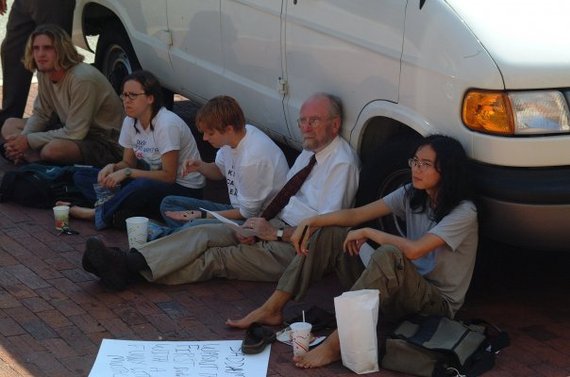
I grew up in the '80s near a Philadelphia still cratered from the MOVE bombings. Reading Comprehension meant "Famous Black Americans," Mary McLeod Bethune and George Washington Carver. There were Black History Month Celebrations and Harriet Tubman lectures. Coretta Scott King herself appeared at an assembly.
66% of my class was white. We received these earnest efforts with a mixture of boredom and resentment.
Then, my fourth-grade teacher explained Jim Crow. Under a banner ordering us to "Accentuate the Positive," Miss Crutchfield told us of a childhood of segregated train stations and bathrooms. And I thought: when you and my mother were girls, you could not drink from the same water fountain. You were separate-but-equal. I cared about Miss Crutchfield, and I cared about the injustice she'd suffered.
February recitations of "I Have a Dream" can't obliterate 300 years of oppression. But how do we teach kids to care about racism? In the wake of Ferguson, more parents want to start talking. We know we want our children to have a personal stake in fighting injustice. But that's about as far as we get.
There are a few things we can do to help kids of all colors understand racism in America. Some tokenism? Probably. But we're battling ingrained cultural assumptions, and we have to start somewhere.
1. Talk about race.
People of color talk and think about race -- they have to. White parents can choose to ignore it -- one more benefit of white privilege. Stop ignoring and start talking. We don't sit our kids down at 16 and explain the birds and the bees. We use proper terms for body parts, answer questions and discuss sexuality in age-appropriate ways. Do the same for race. Use appropriate names: Black, African-American, Native American, Latino/a, immigrants (rather than illegals). Open the door and let your kids' questions take the lead.
2. Integrate the toy chest.
You want your child to see people of color as valued, important parts of their world? Make their toys reflect it. Yes, it's an old liberal cliché for the hippie kid to drag around Black Barbie. But kids need to see possibilities beyond whiteness. Children learn through play. And if we want them to learn diversity, they need to play it.
3. Integrate the book shelf.
Find books that show characters of color -- especially when their color isn't a significant plot point. Corduroy and Lola at the Library both have Black main characters; Mama, Do You Love Me? features an Inuit mother and child. Read Chinese fairy tales and African folklore. Yes, there's a place for hero-biographies of Harriet Tubman and Barack Obama. But save room for Iktomi and the Buzzard. Our world is larger than white-washing would let us believe. Give your kids all the possibilities, not a narrow sliver.
4. Talk about absences.
The town of Chewandswallow isn't exactly swarming with minorities. Hogwarts is run by white people, and let's not touch racism and Tolkien. Where are the South Asian superheroes? The Black people in Dr. Seuss? Make sure your kids know the world they see has missing pieces, missing people and missing stories.
5. Talk about racism they can see.
I hadn't watched Peter Pan in decades when "What Makes the Red Man Red?" jolted me out of Disney nostalgia. We had a long talk about Native Americans that day. Kids understand that more Black kids get called to the principal's office; that more Latino boys populate the lowest reading group. Call racism and racial discrimination by name. My 4-year-old doesn't need to know that the police shot Michael Brown in cold blood. But he can understand that people might not like his friend's dreadlocks.
6. Celebrate, celebrate, celebrate.
Nothing makes you love a culture like its parties, and nothing brings people together like food. Go to Greek festivals, heritage celebrations and Juneteenth block parties. Eat and drink and dance. Yes, these show only the positive parts of a culture. But you have to start somewhere, and somewhere can look a whole lot like empanadas.

7. Diversify your friendships
This is uncomfortable. It can smack of tokenism of the worst sort. And it can be a hard question to face. But how diverse is your group of friends? Do you regularly interact with people of other colors? Do your children? If not, how can you change that? It can be as simple as going to a different playground. You cannot expect your children to value people as authentic community members if they aren't actually part of your community.
8. Watch yourself.
Parenting well takes self-evaluation: it's gutting to hear your own worst self speak in your child's voice. Examine your own prejudices. Be careful about how you speak about people of color -- do you see African-American boys as rowdier and more aggressive, for example? Does your language reflect that?
9. Let your kids hear you.
Angry at the events in Ferguson? Conflicted about the Washington Redskins? Don't hide it. Let your kids hear your speak about racism and white privilege. Find it in the little things, in the way a clerk rolls his eyes at a black kid or Grandpa complains about "illegals." Talk, and keep talking.
10. And don't stop.
Talking about race can be uncomfortable. It's frightening. It's fraught with grief and sadness and rage: the legacy of race in America. Feeling these things means you're getting somewhere. Push through. Keep going. Make discussing race a part of your everyday life. See it. Say it. Listen to stories and tell them. Because it's only when we start to speak, when we join our voices to the chorus of others, that racism will finally disappear.
How do you help your kids confront racism? How do you work to help them recognize people of color as important parts of their own world?